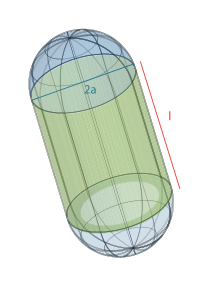The Hille equation relates the maximum ionic conductance of an ion channel to its length and radius (or diameter), with the commonly used version implicitly takes into account a hemispherical cap. As it is ultimately based on a macroscopic continuum model, it does not take into account molecular interactions, and real conductances are often several times less than the predicted maximal flux.
Assumptions and Derivations
| This section is empty. You can help by adding to it. (June 2011) |
Equation

The Hille equation predicts the following maximum conductance for a pore with length , radius , in a solvent with resistivity :
Rearranging the terms, the maximal flux based on length and diameter can be shown to be:
Physical Implications
| This section is empty. You can help by adding to it. (June 2011) |
References
- Hille, Bertil (2001). Ion channels of excitable membranes'. Sunderland, MA: Sinauer Associates. ISBN 978-0-87893-321-1.
This article related to medical imaging is a stub. You can help Misplaced Pages by expanding it. |
This neuroscience article is a stub. You can help Misplaced Pages by expanding it. |
 for a pore with length
for a pore with length  , radius
, radius  , in a solvent with resistivity
, in a solvent with resistivity  :
:

 can be shown to be:
can be shown to be:
